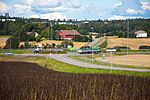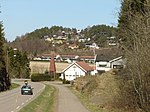Stokke Church
12th-century establishments in Norway19th-century Church of Norway church buildingsBrick churches in NorwayBuildings and structures in SandefjordChurches completed in 1886 ... and 2 more
Churches in Vestfold og TelemarkLong churches in Norway

Stokke Church (Norwegian: Stokke kirke) is a parish church of the Church of Norway in Sandefjord Municipality in Vestfold county, Norway. It is located in the village of Stokke. It is the church for the Stokke parish which is part of the Sandefjord prosti (deanery) in the Diocese of Tunsberg. The brown brick church was built in a long church design in 1886 using plans drawn up by the architect Jacob Wilhelm Nordan. The church seats about 550 people.
Excerpt from the Wikipedia article Stokke Church (License: CC BY-SA 3.0, Authors, Images).Stokke Church
Arne Garborgs vei, Sandefjord
Geographical coordinates (GPS) Address Website External links Nearby Places Show on map
Geographical coordinates (GPS)
| Latitude | Longitude |
|---|---|
| N 59.220616 ° | E 10.306394 ° |
Address
Stokke kirke
Arne Garborgs vei
3160 Sandefjord
Norway
Open on Google Maps









